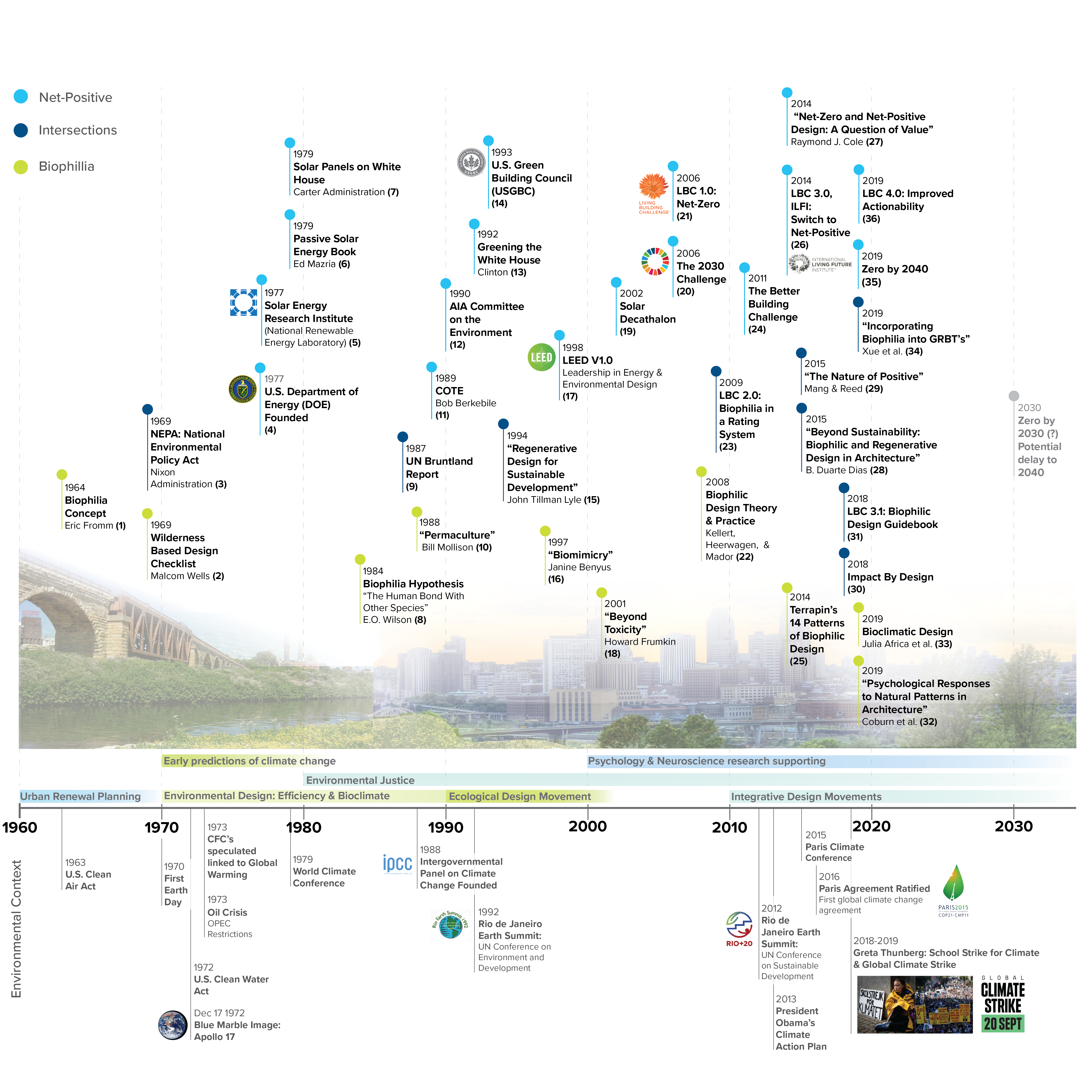
"Without positive benefits and associated attachment to buildings and places, people rarely exercise responsibility or stewardship . . . Biophilic design is, thus, viewed as the largely missing link in prevailing approaches to sustainable design." – Stephen R. Kellert
TIMELINE: Biophilic & Net-Positive Design History

Net Positive
4) (1977) U.S. Department of Energy
5) (1977) Solar Energy Research Institute (later renamed the National Renewable Energy Laboratory)
6) (1979) Mazria, Edward. The Passive Solar Energy Book. Expanded Professional ed. Emmaus, Pa.: Rodale Press, 1979.
7) (1979) Solar Panels on the White House (Carter Administration)
11) (1989) Bob Berkebile (COTE)
12) (1990) AIA Committee on the Environment
13) (1992) Greening the White House (Clinton)
14) (1993) US Green Building Council
17) (1998) LEED (Leadership in Energy & Environmental Design) V1.0
19) (2002) The Solar Decathlon
20) (2006) The 2030 Challenge
21) (2006) LBC 1.0: Aspirations for Net-Zero JKG
24) (2011) Better Buildings Challenge
26) (2014) ILFI's LBC 3.0: Net-Positive added (net-zero dropped)
27) (2014) Net-Zero and Net-Positive Design: A Question of Value Raymond J. Cole
35) (2019) Zero by 2040 extension of the 2030 plan
36) (2019) LBC 4.0: Improved Equity, Directed relationship of project outcomes to effort and conditions
Integration
3) (1969) National Environmental Policy Act (NEPA)
9) (1987) UN Bruntland Report: "Our Common Futures"
15) (1996) Lyle, John Tillman. Regenerative Design for Sustainable Development. Wiley Series in Sustainable Design. New York: John Wiley, 1994.
23) (2009) Living Building Challenge 2.0
28) (2015) B. Duarte Dias "Beyond Sustainability: Biophilic and Regenerative Design in Architecture"
29) (2015) Pamela Mang and Bill Reed "Regenerative Development and Design"
30) (2018) "Impact By Design"
31) (2019) Living Building Challenge 3.1 Biophilic Design Guidebook
34) (2019) Xue et.al "Incorporating biophilia into green building rating tools for promoting health and wellbeing"
Biophilic Related
1) (1964) Fromm, Erich. The Anatomy of Human Destructiveness. [1st Ed.]. ed. New York: Holt, Rinehart and Winston, 1973.
2) (1969) Wells, Malcolm. Gentle Architecture. New York: McGraw-Hill, 1981.
8) (1984) Edward O. Biophilia: the Human Bond with Other Species. Cambridge, Mass.: Harvard University Press, 1994.
10) (1988) Mollison, Bill. Permaculture: a Designers' manual. Erscheinungsort nicht ermittelbar: Tagari, 1997.
16) (1997) Benyus, Janine M. Biomimicry: Innovation Inspired by Nature. New York: Harper Perennial, 2002.
18) Howard Frumkin, Beyond Toxicity: Human health and the natural environment
22) (2008) Kellert, Stephen R., Judith Heerwagen, and Martin Mador. Biophilic Design: The Theory, Science, and Practice of Bringing Buildings to Life. Hoboken, N.J.: Wiley, 2008.
25) (2014) Terrapin's 14 Patterns of Biophilic Design
32) (2019) Alexander Coburn et al., Psychological responses to natural patterns in architecture
33) (2019) Julia Africa et. al, Biophilic Design and Climate Change: Performance parameters for health